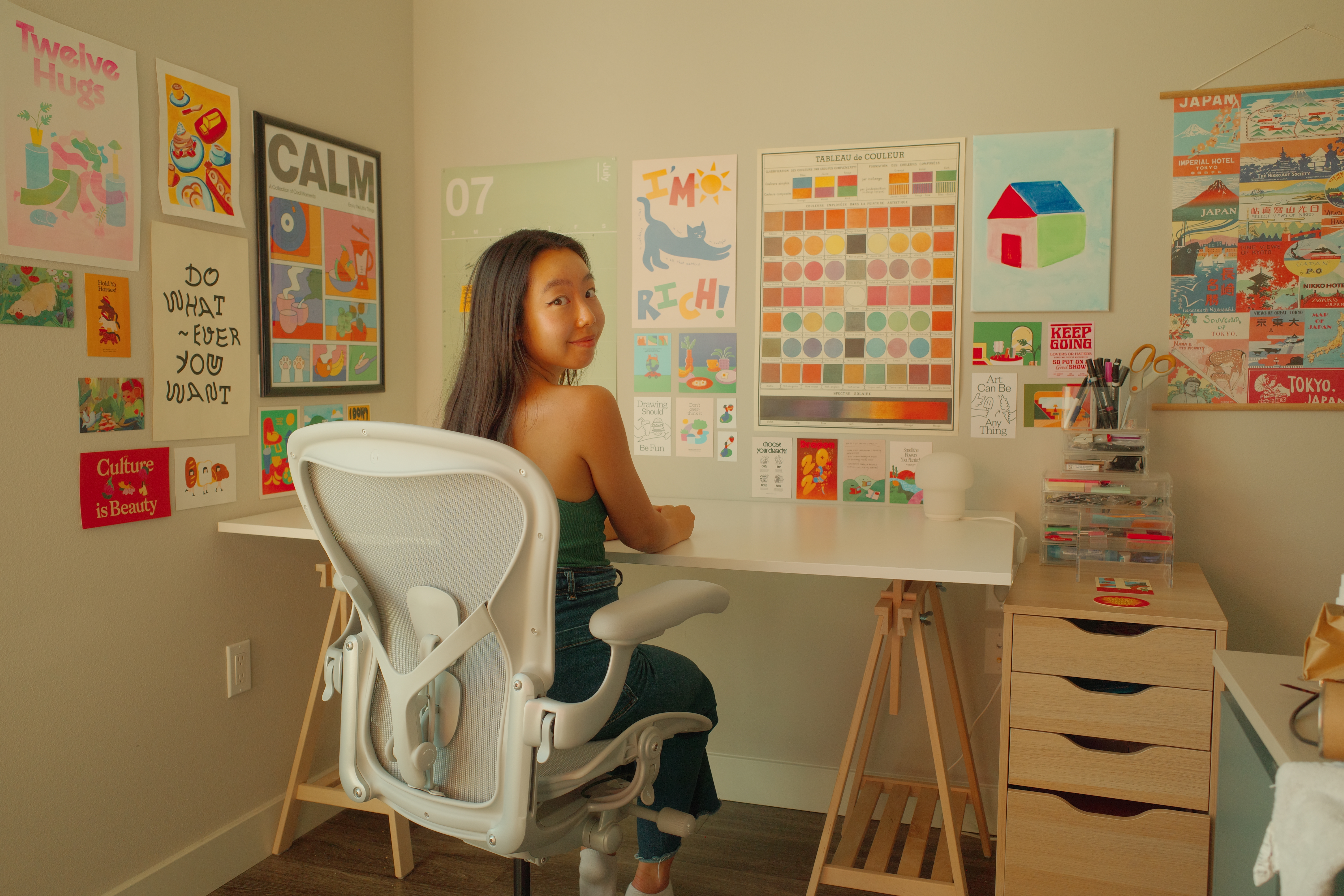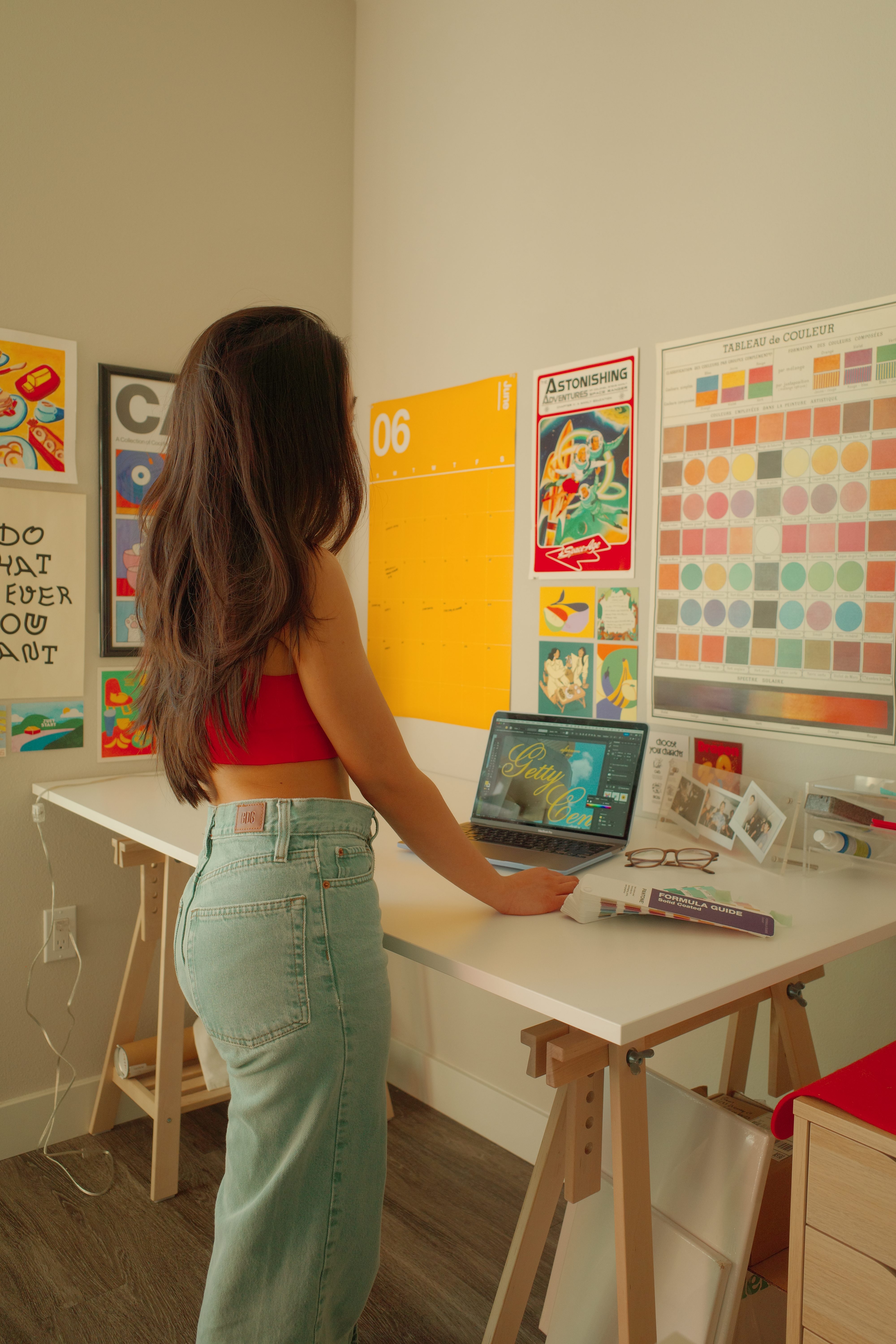Edgykatrina, aka Katrina Romulo, is a self-taught graphic designer who aims to make art more accessible. After leaving her full-time job to pursue freelance work, she has been able to work with brands such as ChapStick and has dedicated her time to creating content across YouTube, Instagram, and TikTok. Romulo hopped on the phone to talk to NYOTA about artists who inspire her, collaboration, and her advice for aspiring artists.

As a kid did you gravitate toward more creative projects like drawing or painting?
My mom was great and set me up with a lot of art classes, so as a kid, I was taking drawing classes and painting classes, and I always gravitated towards the art electives whenever I could. So, I grew up with a lot of creativity around me. My sister was also in a lot of art classes, so I was just surrounded by art constantly, and I have my mom to thank for that a lot. I was naturally always drawn to the arts, but I didn’t fully let myself pursue it until I got to college. I really found my passion for graphic design there when I took a student lit class called Intro to Illustrator and Photoshop at Berkeley. That’s where I found the world of graphic design, and I fell in love with it immediately.
Who are artists that inspire you?
I really, really like Jade Purple Brown. I found her through Instagram. I think she is based in New York, but she’s an illustrator, and her colors are beautiful, bold, and vibrant. I personally use a lot of saturated, vibrant colors in my work as well, so I immediately resonated with that. Another artist that I’ve loved for as long as I can remember is James Turrell. He does these really cool light colorscapes, and they’re all over the world. There’s one in San Francisco, the de Young Museum. It’s a skyscape, and it’s in a tiny building, and you look up, and it’s just a circle, but it looks really beautiful. He plays with light and physical space really well.
Your content often entertains while teaching people something and it seems like a goal of yours is to democratize the art world. Have you felt that social media is allowing for art to become more accessible?
Now more than ever, it’s easier to become an artist, to learn creative skills, and to have art accessible to you; it’s the power of social media and the internet. The way I’ve met so many amazing creative people just through the power of Instagram has been insane. A lot of people, myself included and other creators, have learned almost all of their skills entirely on YouTube, and it’s just through tutorials and things like that. I think it’s a beautiful thing that it can be accessible and free. I was always worried that I would have to go to graphic design school to become a graphic designer, but I didn’t. I wasn’t in graphic design school; I kind of just learned on my own. So that’s the power of the internet and a really good part of the internet. Everything is free, everything’s available, and people are making really high-quality things and just putting them out there for people. I owe a lot of my success and my knowledge to other students at Berkeley who shared their knowledge with me, so I wanted to pass that on.

Is it ever a struggle to keep your creative vision when you’re hired by someone to bring to life what they have in mind for a design?
My job as the designer is to help them figure out what they want. Ideally, they’re coming to me because they like my style, we share similar values, and they already like what I’m putting out, so I don’t have to change myself too much when I’m working with them. My job is to help them figure out what exactly they want. I think a lot of the time; they don’t fully know; they have an idea of what makes sense and what looks good to them, but it’s not a fully fleshed-out idea, and so through a lot of communication and iteration, that’s where we find something. I’ve actually found that the clients who do push back a little bit and challenge me creatively instead of just accepting everything are kind of where the magic happens. There was this studio I used to work for, and one of their sayings was that friction makes fire, which I agree with. When you go back and forth and you have to creatively compromise, sometimes the outcome is way different than you expected, sometimes better than you expected; it’s the beauty of collaboration.
Last year you designed a pop up cafe for Hyper Skin. In a video you shared that your design process doesn’t necessarily change between projects. I’m curious how your thought process and design choices change when you have to create designs for a physical space versus for something static like a poster?
It’s definitely very different when you’re designing for a physical space, just because you have to keep in mind: is everything going to be legible? What size is this actually going to be printed out at? I always think that printing and packaging give me the most anxiety, but they’re also the most fulfilling because when you get it right, it’s a journey to get there. So I’m extra mindful about the colors I choose, how things are reading, and if everything’s legible. If everything looks accessible in real life, that’s super important; versus digital, I get to have a lot more fun, and there are way fewer constraints. It’s not a problem adding textures and really bringing it to life, but both are really fun mediums to work with; it’s just one is a little harder than the other for me.
How do you find the balance between working on creative projects for your own enjoyment and working on projects that are specifically for a client or social media content?
It’s been an interesting journey because I’ve only officially been full-time freelance since January, so before that, I had a whole nine-to-five, and then I had content creation. Then, I had client projects as well, and so I’m starting to get into the flow of things. I’m realizing that there are a lot of fluctuations in between each month. Sometimes, I’ll have five client projects; sometimes, I’ll have one or two, and then let that dictate how many personal projects I get out. It’s definitely a balance, but I do try to work on at least three to four different personal designs a month at the very least, just because it’s a really good outlet; it kind of keeps me sane. I like to say that graphic design is really my coping mechanism; it’s a form of therapy for me. Any time I have a silly thought, or I’m going through an emotion, it’s cathartic for me to turn it into a poster or get it out somewhere in some form, and so that part is really, really important to me, and I don’t think I would want to compromise. Even if I have a super busy schedule and I have a lot of client projects to work on or whatever, I always want to make sure that there’s time for personal projects because that’s the way that I don’t burn out, because that’s essentially just me making things for myself and it just feels necessary almost. It’s definitely a balance, trying to figure out how to live life and do all my work.
What advice do you have for aspiring artists?
I would say practice every single day, honestly. Make something, anything. Every single day. The biggest part is that a lot of people let their fear of being bad at something stop them from even fully starting it. So they’ll be interested in art, and then they’ll like to make a painting, and they’ll be like, this is awful; I don’t want to do this again because people hate being bad at things. When I started getting into graphic design, I was really lucky that I decided to take on this mindset that it’s okay if I’m bad. I just want to have fun, really, and I know that it might take some time to get to the level that I want to be. It took maybe two to three years for me to really start even enjoying or liking anything that I was making, and so giving myself the space to let myself be bad and make bad art really allowed me to fall in love with the process itself and then eventually get better. A lot of people let that fear and that dislike of being bad stop them from ever really fully pursuing their hobbies and their passions, but I think you owe it to yourself to pursue and explore it to the best of your ability, even if you’re not the best at it, it’s totally okay to not be the best at anything.
This story first ran in NYOTA’s Art is Life Issue. Read more from the Issue here and purchase a print copy here.




